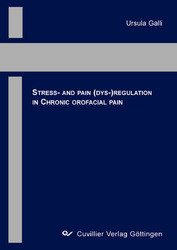| Departments | |
|---|---|
| Book Series (96) |
1379
|
| Nachhaltigkeit |
3
|
| Gesundheitswesen |
1
|
| Humanities |
2367
|
| Medienwissenschaften | 16 |
| Theology | 57 |
| Philosophy | 102 |
| Law | 422 |
| Economics | 851 |
| Social sciences | 416 |
| Sports science | 48 |
| Psychology | 233 |
| Educational science | 190 |
| History | 183 |
| Art | 111 |
| Cultural studies | 166 |
| Literary studies | 117 |
| Linguistics | 88 |
| Natural Sciences |
5407
|
| Engineering |
1793
|
| Common |
98
|
|
Leitlinien Unfallchirurgie
5. Auflage bestellen |
|
Advanced Search
Stress – and – Pain – (Dys)Regulation in Chronic Orofacial Pain (English shop)
Ursula Galli (Author)Preview
Table of Contents, Datei (29 KB)
Extract, Datei (35 KB)
The aim of this research was to examine patients with chronic orofacial pain with
regard to two significant facets of stress and pain regulation – on the one hand the neuroendocrinological system of the hypothalamic-pituitary-adrenal axis and on the other hand subjective illness beliefs, as measured by Leventhal’s self-regulation model (SRM) (Leventhal et al., 1998). The significant effect of psychological and psychosocial factors on the chronicity of pain has been proved in numerous empirical studies and although stress has been investigated for some time as one of the most important psychosocial factors of chronic orofacial pain, there are hardly any studies that examine the underlying mechanisms of the hypothalamic-pituitary-adrenal axis. For this reason we conducted two studies at the interdisciplinary orofacial pain consultant service at the Center for Dental and Oral Medicine and Craniomaxillofacial Surgery of the University of Zurich.
The first study investigated a possible dysregulation of the HPA axis by means of the “low-dose dexamethasone test”. Twenty patients (17 females, 3 males) with chronic myogenous facial pain were dentally examined according to the criteria for RDC/TMD. Further, each underwent a personal interview and completed a series of questionnaires (DIAX, HADS-D, Fatigue Scale, VAS Scales of pain intensity and quality of sleep). The control group comprised 20 healthy subjects, matched by gender, age and BMI. Salivary cortisol was measured on two consecutive days (awakening and daytime profile). 0,5 mg of dexamethasone was administered on the first evening.
Results: in comparison to controls, chronic myogenous facial pain patients showed enhanced and prolonged suppression of cortisol following the administration of 0,5 mg of dexamethasone. Unstimulated cortisol response to awakening and daytime cortisol levels did not differ between the groups. Dysregulation in terms of enhanced negative feedback suppression exists in chronic myogenous facial pain. The second study investigated the predictive value of illness beliefs on therapy outcome in patients with chronic orofacial pain, as measured by the SRM. Relations could be found between subjective illness beliefs and physical as well as psychological adjustment in various chronic illnesses. No research is available to date with regard to chronic orofacial pain. 152 consecutive patients referred to the interdisciplinary orofacial pain consultant service at the Center for Dental and Oral Medicine and Cranio-maxillofacial Surgery, University of Zurich received questionnaires to assess pain and pain related disability, anxiety, depression as well as physical and mental quality of life at three time points: prior to treatment, three and six months after beginning of treatment. Results: Significant improvement over time was found for all outcome measures except mental quality of life. Results of the regression analysis indicated that believing pain could have serious consequences on one’s life (IPQ
subscale consequences) is one of the most important predictors for treatment outcome regarding pain as well as mood in patients with chronic orofacial pain. The belief in low personal control and in a chronic timeline are shown to be predictive for outcome as well, explaining however a smaller proportion of variance. These results provided evidence that even when controlled for pain and mood, beliefs about pain are important predictors for treatment outcome and need to be considered in in the management of patients with chronic orofacial pain. Asking patients about their view of illness can provide essential information about these important predictors. Taken together both studies are in line with a multifactorial etiology of chronic facial pain, shifting the perspective away from a local towards a more central etiology with dysregulations in the stress and pain modulating system and pain related beliefs as important psychological determinants of adjustment to chronic pain.
| ISBN-13 (Printausgabe) | 386727780X |
| ISBN-13 (Hard Copy) | 9783867277808 |
| ISBN-13 (eBook) | 9783736927803 |
| Final Book Format | A5 |
| Language | English |
| Page Number | 108 |
| Edition | 1 Aufl. |
| Volume | 0 |
| Publication Place | Göttingen |
| Place of Dissertation | Universität Zürich |
| Publication Date | 2008-10-27 |
| General Categorization | Dissertation |
| Departments |
Psychology
|








